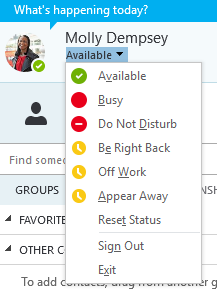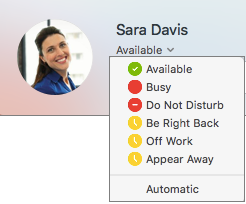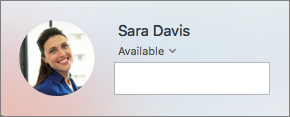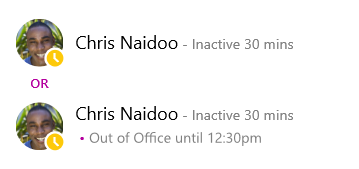Your presence information is a quick way for other people to see your availability status. Presence is automatically set based on your Outlook calendar, but you can change it manually if you want to.
As an example, if you have a meeting currently scheduled in Outlook, your status appears as “In a meeting” in Skype for Business. When you’re in a Skype for Business audio or video call, your presence indicator appears red, as Busy, and your status is updated to “In a call.”
You can also manually set your presence status to include details you want others to see. Your presence can also include a personal note that appears in your Contacts list and on your contact card. This gives people more information about what you’re up to.
Change your presence status
Click the status menu drop-down arrow below your name on the Skype for Business main window, and then click the status you want to show other people.

To revert from the status you set and have Skype for Business automatically update your status, click the status menu and then click Reset Status.
Choose the appropriate status
Make sure you set your status accurately. The following table describes each presence status that other people may see for you, what each status means, and which ones you can set yourself.
Tip: The presence statuses are pre-set in Skype for Business, which means you can’t create a custom status, but you can give your contacts more details about where you are or what you’re doing by adding a personal note. See the next section for details.
|
If your presence is |
It means you are |
How this status gets set |
|
Available |
Online and available to contact. |
Set automatically for you based on your keyboard activity or Outlook calendar. You can also set this status when you want others to know you’re in your office even though the computer is idle. |
|
Be Right Back |
Stepping away from the computer for a few moments. |
You can set your presence to this anytime you want. |
|
Away/Appear Away |
Logged on but your computer has been idle, or you’ve been away from your computer for a specified (set by you) period of time. |
Set automatically for you based on your keyboard activity or Outlook calendar. Skype for Business sets your status to “inactive” when your computer’s been idle for five minutes, and to “away” when your status has been inactive for five minutes. (To change these default values, click the Options |
|
Off Work |
Not working and not available to be contacted. |
You can set your presence to this anytime you want. |
|
Busy |
Busy and don’t want to be interrupted. |
Set automatically for you based on your Outlook calendar. You can also set your presence to this anytime you want. If you manually set it to Busy, it will revert back to your Outlook calendar status in 24 hours, if you do not change it before then. |
|
In a call |
In a Skype for Business call (a two-way audio call) and don’t want to be disturbed. |
Set automatically for you based on your phone activity. |
|
In a meeting |
In a meeting and don’t want to be disturbed. |
Set automatically for you based on your Outlook calendar. |
|
In a conference call |
In a Skype for Business conference call (a Skype for Business meeting with audio) and don’t want to be disturbed. |
Set automatically for you when you have joined a conference call or a meet now session. |
|
Do Not Disturb |
Don’t want to be disturbed and will see conversation notifications only if sent by someone in your workgroup. |
You can set your presence to this anytime you want. If you manually set it to Do Not Disturb, it will revert back to your Outlook Calendar status in 24 hours, if you do not change your status before then. |
|
Presenting |
Giving a presentation and can’t be disturbed. |
Set automatically for you when you are presenting in a Skype for Business meeting. You can change this setting in the Status options window. |
|
Out of Office |
You are out of the office. |
Set automatically for you based on your Outlook calendar. |
|
Out of the office (automatic reply is on) |
You have set the automatic reply feature in Outlook. |
Set automatically for you when you set automatic replies in Outlook. |
|
Offline |
Not signed in. You’ll appear as Offline to people whom you’ve blocked from seeing your presence. |
Set automatically for you based on your keyboard activity or Outlook calendar. |
|
Unknown |
Your presence can't be detected. |
This status might appear to contacts who are not using Skype for Business as their instant messaging program. |
Note: If you use Outlook and you turn on the out-of-office notification, the note you write in Outlook displays in Skype for Business as well, and a red star or asterisk (*) appears next to your presence status at bottom of your picture display area.
Examples of presence scenarios
Confused about offline or out-of-office presence messages? These examples might help.
|
Scenario |
Skype for Business message |
|
|
SIGNED OUT |
||
|
THE VACATION |
Miguel headed out on vacation for a week and turned on Automatic Replies in Outlook to announce it. He already cancelled or declined any meetings during the week he'd be away, and left his laptop signed out and unplugged. |
|
|
SIGNED IN |
||
|
THE CONFERENCE |
Kayo is attending a conference this week a few hours away from town. She turned on Automatic Replies in Outlook to let her customers know she's out of town, but she'll still be getting online with Skype for Business from time to time. |
|
|
THE APPOINTMENT |
Chris is having a regular working week, but needs to visit his doctor during his lunch hour. He blocked out his calendar as Office of Office for 30 minutes so that colleagues will know they shouldn't book his time during that period. |
|
|
THE EMERGENCY EXIT |
Louisa has had an unexpected crisis at home and turned on Automatic Replies in Outlook to announce this. She didn't clear her diary yet, as she's not sure when she'll return. |
|
|
THE LOCK-AND-GO |
Aadi took off on Friday afternoon for a weekend of fishing. He turned on Automatic Replies in Outlook to announce this, then locked his Windows desktop computer and left Skype for Business running. |
|
Add or remove a personal note
Type a personal note, such as “Working from home,” at the top of your Skype for Business main window, to share current details about your status. The note will appear with your contact card. Change the note as often as you like.
To add a personal note
-
In the Skype for Business main window, click the note box above your name, and then type a note, such as “Working from home” or “Working on a deadline, please IM instead of stopping by.”
To remove your personal note
-
Click the note box above your name, and, on your keyboard, press BackSpace, and then press Enter. The text in the box reverts to the default message, “What’s happening today?”
Turn your out-of-office notification on or off
If your Skype for Business account is synchronized to your Outlook calendar, an out-of-office message displays as your personal note in Skype for Business whenever you turn on the out-of-office notification in Outlook. So, for example, when you’re going to be on vacation, you might set up your out-of-office notification in Outlook indicating that you’re on vacation (and sharing any relevant information, such as whether you’ll be checking email and who your backup is). This notification is published in your contact card and other contact listings that are displayed to your contacts in Skype for Business.
Important: When you return from vacation, remember to turn off the out-of-office notification. You have to go into Outlook to do this. You can’t delete the note from Skype for Business.
To turn on the notification in Outlook
-
In Outlook, click File > Automatic Replies > Send automatic replies, and then write your out-of-office message and schedule it for display.
To turn off the notification in Outlook and thereby remove the message from your Skype for Business display
-
In Outlook, click File > Automatic Replies > Turn off. (It can take up to thirty minutes for the note to disappear from your Skype for Business display.)
To sync your Skype for Business and Outlook accounts
-
In the Skype for Business main window, click Options.
-
In Skype for Business - Options, click Personal.
-
Select the Update my presence based on my calendar information check box.
-
Select the Display my Out of Office information to contacts in my Friends and Family, Workgroup, and Colleagues privacy relationships check box to sync your Skype for Business and Outlook accounts.
Change your presence status
Note: Currently. Skype for Business on Mac does not provide presence information based on your Outlook calendar. This will be available in a future update.
Click your photo, click the Available drop-down arrow below your name, and then click the status you want to show other people.

To revert from the status you set and have Skype for Business automatically update your status, click Automatic.
Choose your presence status
Make sure you set your status accurately. The following table describes each presence status that other people may see for you, what each status means, and which ones you can set yourself.
Tip: The presence statuses are pre-set in Skype for Business, which means you can’t create a custom status, but you can give your contacts more details about where you are or what you’re doing by adding a status message. See Add or remove a status message for details.
|
If your presence is |
It means you are |
|
|
Available |
Online and available to contact. |
|
|
Busy |
Busy or and don’t want to be interrupted. |
|
|
Do Not Disturb |
Don’t want to be disturbed and will see conversation notifications only if sent by someone in your workgroup. |
|
|
Be Right Back |
Stepping away from the computer for a few moments. |
|
|
Off Work |
Not working and not available to be contacted. |
|
|
Appear Away |
Logged on but your computer has been idle, or you’ve been away from your computer for a specified (set by you) period of time. |
Add or remove a status message
Type a message, such as “Working from home,” to share current details about your status. Change the message as often as you like.
To add a status message
-
Click your photo, click Click to add status message, and then type a message, such as “In training today” or “Working on a deadline, please IM instead of stopping by.”

To remove your status message
-
Click your photo, click the message you previously left, and then press Delete.
























